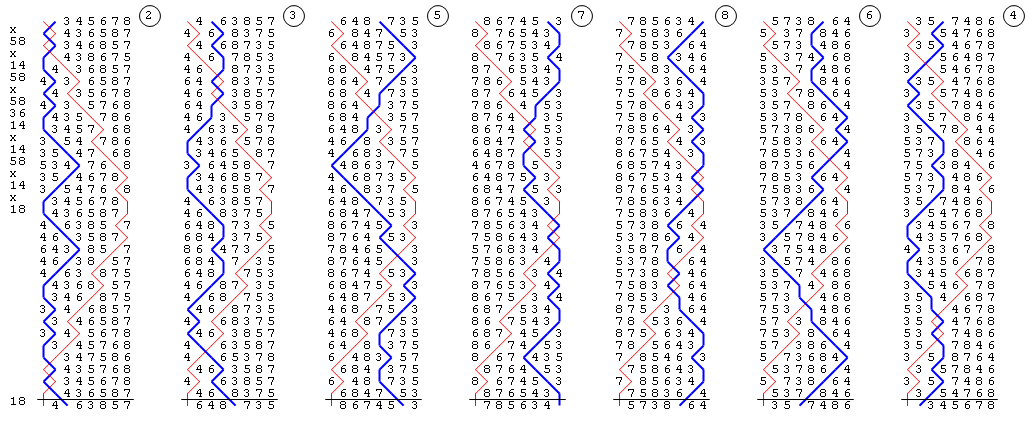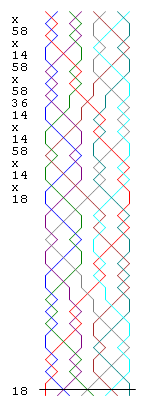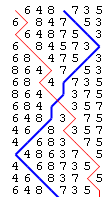Difference between revisions of "Facts about Bristol Surprise Major"
Jump to navigation
Jump to search
(Corrections pointed out by others - thanks!) |
m |
||
| Line 114: | Line 114: | ||
| 5000+ || the number of '''Peals of Bristol Surprise Major''' rung over the last 30 years, including over 300 on handbells. | | 5000+ || the number of '''Peals of Bristol Surprise Major''' rung over the last 30 years, including over 300 on handbells. | ||
|- | |- | ||
| − | | 28512 || the '''Longest composition''' produced for the method to date, composed by Brian Price | + | | 28512 || the '''Longest composition''' produced for the method to date, composed by Brian Price. |
|- | |- | ||
| 23296 || the '''Longest peal''' rung, at Llanfeugan, St Meugan in 13 hours 10 minutes on 15 Jun 1974 (RW 1974-0612), composed by Roderick W Pipe and conducted by Brian J Woodruffe. The composition was a shortened version of a 26880. | | 23296 || the '''Longest peal''' rung, at Llanfeugan, St Meugan in 13 hours 10 minutes on 15 Jun 1974 (RW 1974-0612), composed by Roderick W Pipe and conducted by Brian J Woodruffe. The composition was a shortened version of a 26880. | ||
Revision as of 19:10, 3 July 2011
How well do you know a method, and how much do you know about it? Bristol Surprise Major is probably the most popular and admired method, so what is there to know? This page lists the many properties of the method and provides some associated facts and figures.
| Feature | Description |
|---|---|
| Bristol Surprise Major | the Title of the method; by combining name, class and stage, it is unique - no two methods can have the same title. |
| Bristol | the Name of the method. Unique within class and stage; |
| Surprise | the Class of the method. Surprise is a class that means that it is a treble-dodging method (i.e. has a treble-bob hunt bell) and has an internal place made at every cross-section (when the treble moves up or down from one dodge to the next). |
| Major | the Stage of the method. Major means that it is a method for 8 bells. |
x58x14.58-58.36.14x14.58x14x18x14x58.14x14.36.58x58.14x58x18 |
the Place notation for a lead of the method, a short hand way of defining the changes. It uniquely defines the method. |
| 14263857 | the Leadhead; the row that starts the second lead. It is a Plain Bob, or regular, leadhead which is the same as Kent Treble Bob Major. |
| m or mx | the Leadhead Group; a label given to 8ths place methods with the Plain Bob leadhead 14263857. When written mx, it explicitly signifies the use of fourths place bobs. |
| 24365871 | the Half-leadhead; also the same as Plain Bob, each being an inverted leadhead. |
| 32 | the Length of a lead in changes or rows. |
| 224 | the Length of a plain course in changes or rows. |
| 7 | the number of Leads in a plain course; and the number of Working bells. |
| 1 | the number of Hunt bells. |
| 14 | the place notation for the standard Fourths place bob, which gives the method its extending lead feature i.e. the back four bells repeat the lead. |
| 16 | the place notation for the alternative (n-2)ths place bob, as used more commonly with 8ths place methods of other Leadhead Groups. |
| 1234 | the place notation for the standard 1234 single, used in short touches, quarters and some peal-length compositions. |
| Three leads | a popular and very musical short three-lead touch where a bob is called every lead. |
| Hunter | one of four Types of method. In a Hunter all of the working bells do the same work in the plain course and the number of leads is the same as the number of working bells. |
| Treble-Dodging | the hunt bell has a well-formed path, strikes more than two but the same number of blows in each position of the path within the lead and makes only two places within the lead. |
| Palindromic | it has Palindromic symmetry i.e. is the same when rung backwards. |
| Double | it has Double symmetry i.e. is the same when reversed, when the places within each change are inverted. |
| Rotational | it has Rotational symmetry i.e. is the same when it is simultaneously reversed and rung backwards. If two types of symmetry are present, then the third must be also. |
| Wrong place method | it is a Wrong-place method (as opposed to a right place method) i.e. its place notation does not have the cross change every alternate change, causing wrong hunting and point blows. |
| 87654321 | Back rounds is the half way row in the plain course. Because the method is Double, all the rows in the plain course are the reverse of another. |
| cps | the method is Clean proof scale - a term meaning that there is no internal falseness when composing with bobs alone. |
| c | the False Course Head Group - it only has falseness group, the out of course group "c". This limited internal falseness, combined with the extending lead feature means that there are many millions of ways of producing touches. |
| Extensions | the method can been extended indefinitely and has been rung on all stages up to 16 bells, but it does not contract to Minor. Those wishing to learn Bristol Major would benefit from looking at the Maximus and Royal to understand how it is extended. It may change how they learn it! |
| Music | it is one of the most musical of methods. See Music in Changeringing for details. |
| the Blue line for the plain course; the pattern which ringers learn to be able to ring the method from memory. Also shown underneath the left hand panel of the Wiki. | |
| the Grid for a lead; the pattern of all bells - an alternative view to help understand how the method fits together. | |
| 8642357 | the Order of work i.e. the sequence in which the place bells occur on the blue line of the plain course. |
| Course bells work closely together | Working bells always meet and work with their course bells on the front, the back and in the internal points / Stedman places |
| its blue line contains Point blows, a sequence of right hunting followed by wrong hunting and visa versa creating a point in the blue line. | |
| Fishtail is the name given to the work in the blue line that looks like a fish's tail, or two adjacent points with hunting either side. | |
| Stedman is the name given to the work in the blue line than contains the place-point-place feature occurring in Stedman's principle. In Bristol Surprise Major,
they occur in every pair position. | |
| Lighting work is the name given to the blue line where it passes from a point blow at the back to a point blow on the front and visa versa. | |
| Rev. E Bankes James | the Creator of the method in 1897. He published it unnamed in Bell News of 11 December 1897 (16/394) in reply to an article by Frederick Dench. |
| 22 March 1901 | date of the First peal (but at the seventh attempt) at St Peter's, Brighton, conducted by G Williams. |
| 1 October 1907 | date of the First peal on handbells (rung at the first attempt, after 25 practices) at Romford, conducted by William Pye. |
5,088 Bristol Surprise Major Composed by Stephen J Ivin 23456 M B W H 42356 1 35426 1 1 24536 2 2 25346 1 - 2 2 26543 2 1 23645 2 1 3 part; 144 crus. |
There are many hundreds of Peal compositions of Bristol Surprise Major. The best-known is a three-part 5088 by Stephen J Ivin, containing 144 combination roll ups (crus), first rung at Felmersham on 29th September 1956, conducted by Mark S Lancefield. |
| 5000+ | the number of Peals of Bristol Surprise Major rung over the last 30 years, including over 300 on handbells. |
| 28512 | the Longest composition produced for the method to date, composed by Brian Price. |
| 23296 | the Longest peal rung, at Llanfeugan, St Meugan in 13 hours 10 minutes on 15 Jun 1974 (RW 1974-0612), composed by Roderick W Pipe and conducted by Brian J Woodruffe. The composition was a shortened version of a 26880. |
| 12000 | the Longest peal on handbells, rung at Aston Rowant in 5 hours 12 minutes on 28 Dec 2002 (RW 2003-0104), conducted by Bernard F L Groves. |
| Standard 8 | it is the only 8ths place method in the Standard 8 Surprise Major methods. |
| Pitman’s 4 | it is a member of Pitman’s four compositions of Spliced Surprise Major, with Cambridge, London and Superlative. |
| Nottingham 8 | it is a member of the Nottingham 8 group of methods used in peal compositions of Spliced Surprise Major. |
| Horton’s Four | it is a member of the tricky collection of standard methods known as Horton's four i.e. Belfast, Bristol, Glasgow and London featuring in an all-the-work (atw) peal composition by Roddy Horton. |
| Smith’s 23 | it is a member of Norman Smith’s popular series of peal compositions that work up to 23 Spliced Surprise Major all-the-work. |





